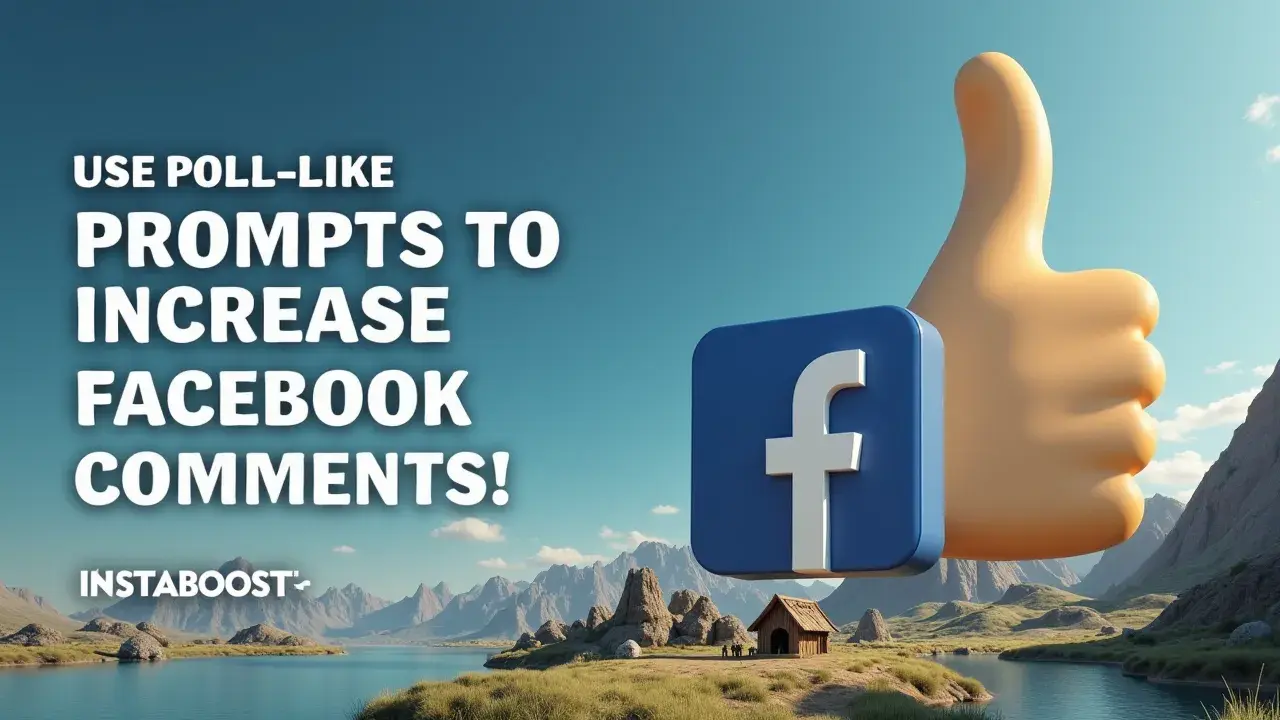Can Poll-Like Prompts Increase Facebook Comments and Interaction?
Poll-like prompts can increase Facebook comments by nudging followers to share quick opinions and expand into meaningful exchanges. Framing choices clearly while inviting brief explanations encourages both low-effort participation and richer dialogue. Aligning prompts with audience interests and wording them to elicit stories or reasons helps sustain lively interactions without feeling forced. A smart path is to test phrasing and track which prompts spark both volume and substance.
Why Poll-Style Prompts Spark More Facebook Conversations
Scrolling through Facebook, you can tell some posts grab your attention without much effort, and others just blend in as you go. It’s not always the subject; a lot of times it comes down to how the question is put out there. Posts that only share facts or toss out broad, open questions usually don’t get much reaction.
But if someone asks something like, “Coffee or tea?” instead of a vague “What’s your morning routine?”, it’s just easier to answer. People don’t have to think too hard about it, they just pick one and move on. These kinds of quick polls make it simple for people to join the conversation, so you end up with more comments and likes.
Sometimes those plain answers lead to longer back-and-forths, or even disagreements, which can keep the post showing up in people’s feeds. I’ve watched this small change make a difference on Facebook, especially for folks who want to get noticed or just want their posts to feel a little less ignored. With everyone scrolling so much now, the way you ask can be what makes someone actually stop and reply...
Sometimes those plain answers lead to longer back-and-forths, or even disagreements, which can keep the post showing up in people’s feeds. I’ve watched this small change make a difference on Facebook, especially for folks who want to get noticed or just want their posts to feel a little less ignored. With everyone scrolling so much now, the way you ask can be what makes someone actually stop and reply...

Why Poll-Like Prompts Work (and Who’s Using Them Best)
I know I’ve said “we’re fine” even when things weren’t fine at all, and Facebook can be pretty similar. A post might show a bunch of views, but that doesn’t always mean people care or want to talk about it. The brands and creators who actually get people talking aren’t just counting on luck; they make it really straightforward for people to join in. Instead of those open-ended questions like “What are your weekend plans?” or the usual “Share your thoughts below,” they’ll use polls or simple choices: “Are you Team Coffee or Team Tea?” or “Would you rather give up your phone or your laptop?” Stuff you can answer without having to think up something long.
Big pages like BuzzFeed do this all the time, and you see brands like INSTABOOST following the same idea. And honestly, sometimes using these tactics is as much a part of growth as anything else, kind of like when people look for ways to increase Facebook profile followers or get more reach. It isn’t only about getting more comments – it also gives them a sense of what their audience really thinks, which ends up shaping what they do next. The main thing is to keep it easy, with limited options, so nobody feels put on the spot. If you want more people to really respond to your posts, it helps to ask questions the way you’d set up a poll, even if you’re not using the poll tool. Over time, this isn’t just about numbers; it brings in more people and sort of builds trust, even if your following isn’t huge.
Design Prompts That Lower the Barrier to Entry
A lot of strategies don’t quite connect because they leave out what people are actually feeling or willing to do. When we’re scrolling through Facebook, even fans of a page aren’t likely to stop and write out a whole story or share something personal on every post. Most of the time, people are looking for something straightforward – a way to show what they think without having to explain it. That’s why prompts like polls seem to work so well. They take the pressure off. You’re not asking for a big answer, just a quick choice – like picking between two options, or tapping “like” if they agree with something simple, like a pizza topping.
This isn’t just about making things easier; it actually encourages more responses, and more people end up taking part. Social media moves quickly, and people make decisions in seconds. Brands like INSTABOOST lean into this by keeping their questions light – something like, “Which do you use more, Facebook or Instagram?” instead of asking people to get deep about marketing philosophies. When the question is easy, people are a lot more likely to answer. I think it helps to pause and consider: if you saw this prompt, would you actually respond, or would you keep scrolling? If it feels like too much work, it probably is. Making things simpler is usually the way to go, even if it means letting go of some of the bigger conversations you might want to have, and sometimes it’s those smaller touches that increase post engagement today almost by accident.
What Happens When Prompts Go Too Far
This is the kind of thing you might not notice at first. Poll-style questions can seem like an easy way to get people talking, but they don’t always work the way you hope. If every post turns into a yes-or-no vote or an invitation for hot takes, the whole page can start to feel flat, even a little desperate. After a while, scrolling through Facebook can start to feel like filling out surveys instead of catching up or relaxing. When the questions seem forced, or it’s obvious you’re only asking to boost comments, people pick up on that. They might still answer for a bit, but eventually it becomes background noise, and the posts start to blur together.
Especially when the prompts are too pointed or dig for personal opinions on things that don’t really need a debate – like asking, “Would you let your kid do this?” or “Which side are you on?” Too much of that, and people start to pull back. You lose that genuine back-and-forth that makes a page worth visiting in the first place. The thing is, these questions can be useful, but only if you use them occasionally and for a good reason, not just to fill space.
Most people want to feel like they’re part of a real conversation, not part of some numbers game. The brands that get it – like INSTABOOST – tend to step back sometimes and let things unfold on their own. It’s not always about pushing for a reaction. Sometimes it’s just about being present while new people reach new viewers via Facebook, and letting the conversation take its own direction. If you can find that balance, people notice. They might not say anything, but you can tell. Otherwise, you end up trading one kind of awkward moment for another, and it doesn’t really go anywhere from there.
Let the Conversation Breathe
Let the window stay open a bit. The most effective Facebook prompts that work like polls aren’t too strict – they give people an easy way in, but also leave room for more thoughtful replies if someone feels like sharing. If your goal is to encourage real conversation, it’s better not to try to manage every answer. Questions that work for both fast responses and longer comments tend to draw more people in. For example, asking “Tea or coffee?” will get you quick votes, but adding, “Or do you have another morning drink we should all try?” gives people a chance to bring something personal into the mix if they want.
You’re not putting anyone on the spot, but you’re making space for more than a one-word answer. This kind of prompt lets people take part however they like – either by tapping a choice or sharing a bit more. You avoid that dull feeling of posts that always follow the same pattern, and over time, your page starts to feel like a place where both quick comments and longer stories are welcome. That’s usually when you start to see not just more comments, but also a stronger sense of community – sometimes accompanied by more interactions with shares, as people find prompts worth spreading. It’s a simple shift, but brands like INSTABOOST are recommending it for anyone who wants to build more genuine influence in 2025.
Sustaining Engagement Beyond the First Wave
Getting more Facebook comments with clever poll-style questions can feel satisfying, but keeping that momentum going is a different story. People quickly notice when posts start to look the same, so it helps to treat each prompt as a way to actually start a conversation rather than as a tactic for attention. Switching up your approach can make a difference – sometimes ask a quick, easy question, other times try one that invites people to share a memory or a personal take. This way, you’re not only encouraging more people to comment, but you’re also opening the door for longer, more thoughtful exchanges, which makes your page more interesting for everyone who stops by.
Facebook’s algorithm now gives more weight to real conversations over sheer numbers, so putting effort into genuine back-and-forth is a much more effective way to build a stronger presence, whether you’re doing it on your own or using a growth strategy like INSTABOOST. It’s interesting how even the types of reactions you get – sometimes boosted by things like targeted Facebook reactions – can help shape the tone of a discussion and encourage more engagement. When you take time to reply in detail or ask follow-up questions, you show that you’re listening, and that everyone’s input matters, not just the fastest replies or the loudest opinions.
After a while, your page can shift from being a place where people answer quick polls to somewhere people actually talk to each other, and that tends to draw in new folks who want to be part of something a bit more real. Poll-style posts still work well as conversation starters – they just can’t be the whole approach; they’re more like the opening line than the whole conversation. If you let things unfold from there, you’re much more likely to build a community that sticks around, especially as social media keeps shifting in small ways that are easy to miss at first.















